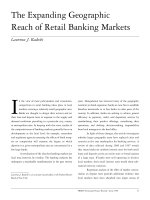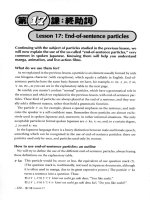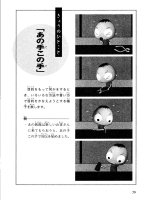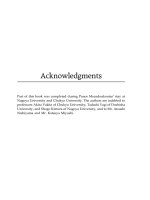The Rise and Fall of Abacus Banking in Japan and China phần 5 doc
Bạn đang xem bản rút gọn của tài liệu. Xem và tải ngay bản đầy đủ của tài liệu tại đây (272.19 KB, 21 trang )
62 The Rise and Fall of Abacus Banking in Japan and China
Total working hours are recognized internationally as long. In the eyes of many
observers, these differences symbolize the failure of workers to share Japan’s
success. After all, we associate long working hours with poorly developed econ-
omies, and short working hours with advanced industrial nations. Japan seems
to be an anomaly in this regard.
7
Compounding the problem of small houses, long working hours, and
a high cost of living is a poor infrastructure that lags behind those of
other industrialized countries. ‘‘In areas ranging from roads to sewer
systems to airports, Japan is said to be so far behind her counterparts in
the West as not to deserve the label of an advanced developed country.’’
8
Japan’s main sewage system, for instance, serves only 40 percent of the
population, compared to 73 percent and 95 percent of the population
served by the corresponding U.S. and British sewage systems.
9
In 1990,
the average urban Japanese enjoyed 2.2 square meters of park space,
compared to 19.2 for the average American living in New York City, 30.4
for the average urban Englishman, and 37.4 for the average urban
German.
10
Japan’s rapid rise of asset values, currency appreciation, and economic
growth, in conjunction with unfavorable demographics, had another
negative impact on the Japanese economy—the erosion of her competi-
tive position. Rapid economic growth, for instance, along with an aging
labor force, declining working hours, and tight emigration policies, cre-
ated severe labor shortages that pushed labor costs higher.
11
Rising labor
costs and rising commercial leases, and especially the stronger yen, in
turn priced many of Japan’s products out of world markets, contributing
to ‘‘hollowing out,’’ the transfer of traditional manufacturing operations
offshore.
12
Hollowization of the economy is closely related to the movement in exchange
rates because the appreciation of the exchange rate will lead to the substitution
of imports for domestic production, the substitution of overseas production for
domestic production, and the shift in resource allocation from production of trad-
able goods to production of nontradable goods.
13
Indeed, the precipitous rise of the yen has made it difficult for Japanese
companies, especially consumer electronics companies, to compete effec-
tively in world markets without shifting production in overseas trans-
plants to the United States, the European Union, and especially Asia. In
fact, according to some estimates, a 1 percent yen appreciation is fol-
lowed by a 1.6 percent increase in Japanese investment in Asia.
14
Al-
The Fall of Abacus Banking in Japan 63
ready, almost 70 percent of the color television sets and about 30 percent
of VCRs are made overseas. Japanese companies, like Uniden, the cord-
less telephone maker, have already relocated their manufacturing out-
side of Japan.
15
A conformation of this trend is the reduction in Japan’s
surplus with the United States and an increase in China’s and Southeast
Asia’s surpluses with the United States on the one side and the rise of
trade deficits of these countries with Japan on the other side.
16
‘‘Hollowing out’’ had two major impacts on the Japanese economy.
First, it weakened the traditional keiretsu relations, intensifying compe-
tition. Second, it fueled a ‘‘softomization’’ of the economy (the growing
importance of services over manufacturing), which has contributed to
the slowdown of economic growth. In 1995, the service sector provided
for 55.8 percent of the GDP and 59 percent of employment; the corre-
sponding figures for the United States were 68.8 percent and 72.5 per-
cent. The industrial sector provided for 41.9 percent of the GDP and 34.6
percent of employment; the corresponding figures for the United States
were 29.2 percent and 24.6 percent (see Exhibit 3.4).
As discussed earlier, Japan is further beset by demographic problems
arising from the aging of the country’s population, which has contrib-
uted to the country’s labor shortage and has further challenged the coun-
try’s three major labor institutions (lifetime employment, seniority
wages, and enterprise unionism) and has strained Japan’s government
finance, turning her fiscal surplus into deficit. In this sense, the country
found herself in a situation where it criticized her trade partners, mainly
the United States. In 1996, Japan’s combined central and local govern-
ment deficit approached 7 percent of the GDP, one of the largest among
OECD countries.
17
Last but not least, due to the continuing regulation of certain domestic
sectors, Japan has been suffering from an accumulation crisis, the lack of
opportunities to re-invest profits accumulated in the export sector: Ac-
cording to Hirsh and Henry,
The message of the multinationals is this: The low productivity and growth of
this over-regulated marketplace no longer work for us. Japanese firms across the
board have seen a dramatic deterioration in the break-even points and efficiency
of their Japan-based operations.
18
Reflecting this trend, the former chairman of Toyota Motor Corporation,
Shoichiro Toyoda, calls for a ‘‘shift from an economy burdened by reg-
ulations to one in which the private sector can operate unfettered.’’
19
The
Exhibit 3.4
Employment and GDP by Sector in 1995
Source: OECD Observer (June/July 1996).
The Fall of Abacus Banking in Japan 65
lack of opportunities reinforces the hollowing out of the economy (dis-
cussed earlier), eventually feeding into the speculative frenzy that will
be discussed in the next chapter.
In short, Japan’s early efforts to open her markets to foreign products
and competition, especially the hyperliquidity that followed the Plaza
Accord, had a mixed impact on her economy. On the one side, it accel-
erated the country’s economic growth, boosting equity and real estate
prices. On the other side, it raised the country’s already high cost of
living, further opening the gap between the country’s production and
consumption potential, leading to a hollowing out. In the meantime, un-
favorable demographics raised the country’s government deficit, while
deregulation limited investment opportunities in a number of domestic
sectors. Life became even more expensive for Japanese consumers, and
competition became even tougher for Japanese producers.
To address these new challenges, Japan reversed some of her earlier
measures and accelerated others. To contain hyperliquidity and rising
asset values, the BOJ tightened up the money supply, raising the official
discount rate five times, from 2.5 percent in 1989 to 6 percent in 1990; it
also imposed restrictions on land transactions and bank loans. Japan’s
broad money supply dropped from 10 percent in November 1990 to
below 1 percent in 1992 before bouncing back to around 3 percent in
1994 (see Exhibit 3.5).
In the meantime, as part of the ongoing GATT negotiations and the
establishment of the WTO, Japan continued to slash tariff and non-tariff
trade barriers in line with her major trade counterparts. Specifically, with
the exception of some agricultural products and alcoholic beverages, Ja-
pan slashed tariffs to 2.6 percent, well below the 3 percent level for the
United States and the 2.9 percent level for the European Union.
20
Tariffs
continued to drop even further after the establishment of the WTO (see
Exhibit 3.6). Product standards and certification systems were adjusted
in line with those of other industrialized countries. The Electrical Appli-
ances and Material Control Law, for instance, simplified certification for
foreign appliances and electric products. The Measurement Law simpli-
fied the procedure for the importation of measurement devices, and a
24-hour import clearance service was established.
Japan further continued to make progress in such highly protected
sectors as agriculture and finance. In the agricultural sector, for instance,
under pressure from the country’s two main beef suppliers, Australia
and the United States, Japan reached an agreement that provided a two-
stage liberalization of beef imports. In the first stage, from 1988 to 1990,
66 The Rise and Fall of Abacus Banking in Japan and China
Exhibit 3.5
Japan’s Broad Money Supply Growth
Source: Bank of Japan.
import quotas were raised from 274,000 metric tons to 394,000 metric
tons, maintaining a 25 percent tariff. In the second stage, from 1991 to
1993, quotas were raised from 472,000 metric tons to 680,832 metric tons,
and tariffs were raised to 50 percent.
In the financial sector, Japan continued to deregulate deposits, secu-
rities commissions, and currency transactions.
• June 1992: Revision of laws regulating financial system is approved.
• June 1993: Interest rates on time deposits are fully liberalized.
• October 1994: Interest rates on demand deposits are liberalized.
• November 1996: Deregulation of fixed commissions on securities begins.
• June 1997: The Financial Supervisory Agency (Kinyu Kantokucho) is established
to oversee the fairness and transparency of the financial system, a function
previously performed by the MOF.
Exhibit 3.6
Average Tariff Cuts Achieved in the Uruguay Round for Industrial Goods
Source: World Trade Organization, 1996.
68 The Rise and Fall of Abacus Banking in Japan and China
Exhibit 3.7
Real GDP Annual Growth in Major Industrial Countries for Selected
Periods
Sources: The Europa World Year Book 1992/94 (London: Europa Publications); OECD, Eco-
nomic Outlook 1994 (Paris: OECD, 1994); International Monetary Fund, World Economic
Outlook (Washington, DC: IMF).
• 1998: Amendments are made to the Bank of Japan Law to eliminate one of the
two former policy-making agencies (the Directors Meeting) and to strengthen
the other (the Policy Board), turning it over to the sole policy-making body of
the BOJ.
• April 1998: The Big Bang; Foreign Exchange and Foreign Trade Law takes
effect, liberalizing cross-border transactions; commissions on stock transactions
in excess of 50 million yen are deregulated; investment trusts are created; fi-
nancial disclosure rules are strengthened; and the diversity and efficiency of
financial markets are improved.
The reversal of monetary policy, the continuation of government de-
regulation, unfavorable demographics, the soaring yen, and tighter land
financing rules took a new toll on the economy, again most notably on
the banking sector. Tight monetary and fiscal policies, for instance,
caused a prolonged economic stagnation, eliminating a risk cushion, a
condition for abacus banking. Indeed, Japan’s economy slid into the
worst stagnation and recession in the postwar period. The GDP dropped
from 6.1 percent in 1988 to 5 percent in 1991 and to negative territory
by 1994 (see Exhibit 3.7), and with the economy sliding into the recession,
unemployment increased from 2.5 percent in 1991 to 3 percent in 1994.
As economic growth declined, real disposable income growth and sav-
ings followed suit. Real disposable income growth fell from 6 percent in
1998 to less than .5 percent in 1993, while the savings rate dropped from
16 percent in 1987 to 12 percent by 1994.
21
Low savings in turn lowered
the flow of deposits, especially since regulation provided investment al-
ternatives. M2 (a broad measure of money supply) growth declined from
about 10 percent in 1987 to 2 percent by 1993, while M2 ϩ CD (certifi-
The Fall of Abacus Banking in Japan 69
cates of deposit) declined from nearly 12 percent in 1987 to nearly 0
percent in 1993. Such a decline in the flow of deposits in turn compelled
banks to raise lending rates and scale back credit. Credit growth rates
fell from 5.5 percent in 1990 to nearly 3 percent in 1995.
22
Economic stagnation and excess capacity turned asset inflation into
deflation, eliminating yet another condition of abacus banking. Stock and
land prices began to come back to earth, profits dropped, and bank-
ruptcies soared. By 1994, the Nikkei average was back to around 15,000,
and land prices dropped by 30 percent, an issue which will be further
addressed in the next chapter.
Economic stagnation was associated with diminishing corporate prof-
itability that reduced corporate investment, eliminating a third condition
of abacus banking. The profit-to-sales ratio, for instance, fell from 4 per-
cent in 1988 to 1.5 percent in 1993.
23
Lower profitability in turn took its
toll on corporate investment and corporate borrowing. Nominal corpo-
rate investment growth fell from 18 percent in 1988 to Ϫ12 percent in
1993.
24
The annual growth of loans to the property industry fell from 15
percent in 1989 to below 5 percent in 1992. Corporate bankruptcies in-
creased from around 6,000 in 1989 to 12,000 in 1992. In addition, the
curtailing of a long-standing BOJ policy of overlending further con-
strained the ability of banks to extend corporate loans. In fact, in 1990,
the BOJ ordered banks to scale back corporate lending by 30 percent.
25
The loosening up of keiretsu relations undermined the loan diversifi-
cation function of the main bank, eliminating a fourth condition of ab-
acus banking. In 1990, the share of the big six keiretsu groups in current
income dropped to 13.3 percent, and their share in the workforce
dropped to 4 percent from the corresponding shares of 16.9 percent and
4.0 percent in 1985. In the meantime, the percentage of non-financial
shares held by banks dropped from around 17 percent in 1988 to around
15 percent in 1997, while the percentage of bank shares held by non-
financial firms dropped from 45 percent in 1988 to 40 percent in 1997.
26
The percentage of equity of Bank of Tokyo of Mitsubishi held by other
companies dropped from 26 percent in 1990 to 14 percent in 1998.
27
In short, the tightening of fiscal and monetary policy in the early 1990s
eliminated most of the conditions of abacus banking. But what presented
the final blow to abacus banking was the disbanding of the Gosou-sendan
Houshiki, the ‘‘escorted convoy’’ system of financial regulation, the sailing
away of the MOF ‘‘destroyers’’ that protected Japanese banks both from
within and without competition (see Exhibit 3.8). Specifically, the contin-
ued liberalization of demand and time deposits further intensified the
70 The Rise and Fall of Abacus Banking in Japan and China
Exhibit 3.8
The Disbanding of Gosou-sendan Houshiki
competition between the banking and non-banking industries, raising
deposit rates. Worse, coming later than earlier, deregulation took full
effect at a bad time for the Japanese banking industry, during a period
when economic slowdown and asset deflation had already had a per-
vasive impact. According to Nukazawa,
In the financial sector the regulation and protection of segregated financial in-
dustries in the name of preserving the stability of the financial system lasted too
The Fall of Abacus Banking in Japan 71
long. No doubt it is difficult to get the timing right when outdated regulations
need to be removed. The Japanese version of Big Bang now being readied will
deal this sector a severe blow just when it is on its knees, and I can sympathize
with the people working in it.
28
Compounding the problem of poor timing of deregulation is the in-
consistency in which it was introduced. Specifically, while on the one
side the MOF lifted a number of financial regulations, it maintained its
tight controls over bank management. Deregulation unleashed compe-
tition, but deprived bank managers the freedom to take the appropriate
measures to deal with the new environment. As Tanaka observes: ‘‘The
1980s saw the rapid deregulation of interest rates, but it did not bring
an atmosphere of freedom for banking executives to develop their insti-
tutions’ operations as they thought best.’’
29
In short, under external and internal pressures, Japanese policy makers
initiated a number of measures that took the Japanese economy on a
roller-coaster ride, known as the bubble economy, and its burst, a course
that led to the decline and fall of abacus banking. Competition between
banking and non-banking institutions intensified, the interest rate spread
turned negative, corporations shifted from bank to equity financing, kei-
retsu relations weakened, economic growth and savings slowed down,
and asset values declined.
By the early 1990s, Japanese banks found themselves competing
against their U.S. and European counterparts in a fast-paced global econ-
omy with more opportunities and more risks. Japanese banks found
themselves without the MOF apparatus that made things work, which
brought an end to abacus banking and began the banking crisis, issues
that will be addressed in the next chapter.
NOTES
1. Quoted in Horvat (1998).
2. Ibid.
3. According to some estimates of the Institute for International Economics
in Washington, non-tariff barriers double the cost to Japanese consumers of many
imported products. In 1989, for instance, trade barriers cost Japanese consumers
10–15 trillion yen, which translates to between 2.6 percent and 3.8 percent.
4. C. Prestowitz, ‘‘Getting Japan to Say Yes,’’ The Washington Post Weekly,
January 31–February 6, 1994.
5. OECD (1993), p. 49.
72 The Rise and Fall of Abacus Banking in Japan and China
6. T. R. Reid, ‘‘Lifestyles of the Rich and Foolish,’’ The Washington Post Weekly,
November 18–24, 1991.
7. R. E. Cole, ‘‘Work and Leisure in Japan,’’ California Management Review
(Spring 1992).
8. Kunio (1979).
9. Lawrence (1998), p. 50.
10. JETRO (1994), p. 9.
11. Japan’s population is graying; the percentage of elderly persons is reaching
the alarming threshold of 10 percent, and by the year 2000, it will exceed 15
percent, creating a number of problems for the Japanese economy.
12. According to the estimates by the Japanese Ministry of Labor, the labor
force was expected to expand by 0.8 percent annually in the first half of the 1990s
and by 0.4 percent in the latter part, compared to 1.2 percent in the 1980s, and
wages were expected to climb by 30 percent, three times the rate of inflation. See
A. Ono, ‘‘Making the Most from Japan’s Untapped Labor Resources,’’ Economic
Eye, Vol. 13, No. 1 (Spring 1992).
13. Economic Planning Agency (1995).
14. Ibid.
15. A. Pollack, ‘‘Japan’s Companies Moving Production Overseas,’’ New York
Times, August 29, 1993.
16. ‘‘Shellshocked by the Yen, Japanese Companies Still Find Ways to Cope’’
(1995).
17. OECD (1996), p. 3.
18. M. Hirsh and E. K. Henry, ‘‘The Unraveling of Japan Inc.,’’ Foreign Affairs,
Vol. 76, No. 2 (March–April 1997), p. 11.
19. S. Toyoda, ‘‘Dismantle Japan, Inc.,’’ New York Times, April 17, 1997.
20. Japanese Ministry of Finance.
21. OECD (1995, 1996).
22. OECD (1997), p. 19
23. OECD (1994b), p. 23.
24. Ibid.
25. Ibid., p. 106.
26. ‘‘Stock Sales Cut into Cross-Holdings,’’ Nikkei Weekly (editorial), January
11, 1997, p. 11.
27. B. Bremner, E. Thornton, and I. Kunii, ‘‘Fall of a Keiretsu: How Giant
Mitsubishi Group Lost Its Way,’’ Business Week, March 15, 1999.
28. Nukazawa (1998), p. 27.
29. Tanaka (1998), p. 22.
Chapter 4
The Banking Crisis
Imagine, after walking in on the middle of a poker game, that you
are asked to choose which player will be the ultimate winner. Would
you automatically pick the player with the biggest pile of chips?
If your answer is no, then you believe in risk adjustment. You
realize that it matters how a player won its chips. If he did so with
one lucky bet, he is unlikely to be the overall winner.
—Mark Hulbert
1
The market goes to extremes—both on the downside and upside—
but has a nasty habit of eventually steering itself back towards ra-
tionality.
—Robert Sobel
2
For over a century, Japan’s banks financed the country’s successful in-
dustrialization. In the 1950s and the 1960s, they financed the country’s
transformation from a labor-intensive economy to a capital-intensive
economy. In the late 1970s and the early 1980s, they financed the coun-
try’s transformation from capital-intensive industries to technology-
intensive industries and the overseas expansion of the country’s large
corporations. In the late 1980s, they rescued American counterparts,
climbing to the summit of the world’s financial system, drawing both
the fear and the admiration of the Western world. In 1986, seven of the
74 The Rise and Fall of Abacus Banking in Japan and China
world’s ten largest corporations were Japanese, compared to none 30
years earlier (see Exhibit 4.1).
Japan’s banks reached the summit of the world economy without any
special effort, any active or subtle strategy, collecting and counting
‘‘chips,’’ equities, and real estate with the abacus, the ancient Chinese
calculator, and within the ‘‘escorted convoy’’ system. Yet as was the case
in the ancient Greek myth of Sisyphus, who rolled his rock all the way
to the top of a hill, only to have it roll down again, Japanese banks could
not hold onto their position at the top. Their abacus calculators could
not account for a major change in the banking environment, the liber-
alization and deregulation of the world markets, which turned banking
from a simple accounting procedure to a complex, risk-management pro-
cedure. Their abacus calculators could not detect and prevent the spec-
ulative mania that swept the country—it rode along with it. Like the
Sisyphus rock, banks rolled downhill, dragging along the entire economy
and its notorious gatekeepers, the omniscient regulators of the MOF. By
1998, one out of ten of the world’s largest banks was Japanese, compared
to seven out of ten in 1988 (see Exhibit 4.1).
In addition, Japanese banks lost clout even in the Asian region. In 1998,
for instance, Japan’s banks failed to register in the top ten lenders in the
region, and many of the country’s largest banks and financial corpora-
tions suffered heavy losses, drawing lower debt grades by credit insti-
tutions. Tokai Bank, for instance, dropped three grade notches, Sakura
Bank dropped four, and Daiwa dropped five (see Exhibit 4.2). Nikko
Securities’ bond rating dropped one grade notch, Nomura Securities
dropped three and Yamaichi dropped five, eventually filing for bank-
ruptcy (see Exhibit 4.3). According to some estimates, Japan’s banks and
savings and loan associations have accumulated close to $400 billion,
even $500 billion of non-performing assets, a figure that dwarfs that of
the U.S. banking crisis in the 1980s.
3
In this sense, Japan’s speculative mania and the banking crisis that
followed can find parallels to a number of manias that swept Europe
and the United States in the previous centuries:
• The speculation and collapse of the South Sea Company and the government
debt in the early eighteenth century in England and the panic of 1720; the Canal
mania in the late eighteenth century and the panic of 1793; the speculation in
the railways, wheat, and equities in the nineteenth century and the panics of
1847 and 1890, which led to the near collapse of the Baring Bank.
4
• The Mississippi company speculation and the panic of May 1720 in France; the
Exhibit 4.1
The World’s Ten Largest Banks (1982–1998)
Source: Statistics Bureau, Japan Statistical Association (various years).
Exhibit 4.2
Standard & Poor’s Long-Term Issue Credit Ratings (1991–1998)
Source: Compiled from various Standard & Poor’s publications.
Exhibit 4.3
Standard & Poor’s Bond Ratings (1986–1997)
78 The Rise and Fall of Abacus Banking in Japan and China
Canals and the Paris bank speculation and the panic of 1827; the regional bank
crisis and panic of 1837; the speculation in the stock of new banks and the
panic of 1882; the overlending to the industrial sector that led to the panic of
1907, which spread to Italy; the currency speculation, which led to the panic
of 1958; the speculation in commodities and the panic of 1799 in Germany; the
speculation in heavy industries, in Credit Mobilier, and in new German banks,
which led to the Hamburg panic of 1844; the speculation in new banks, broker
banks, and construction banks, which led to the panic of 1873.
• The speculation in the Wildcat banks of the free banking era in the United
States and the crush of 1837; the speculation in the railroads, public land, and
gold, which led to the panic of 1857; the speculation in trust companies and
the crush of 1907; the speculation in stocks, real estate investment trusts, and
the Eurodollar market, which led to the crush of 1974–1975.
As has been the case with previous speculative manias, Japan’s spec-
ulative mania and the banking crisis that followed can be traced to a
mob psychology driven by the complacency and euphoria of Japanese
investors and bankers and their failure to apply the basic principles of
risk management in evaluating investment alternatives, as well as the
failure of regulators to take preemptive measures to curtail the mania
and avert the crisis. Specifically, Japan’s speculative mania and the bank-
ing crisis were caused by a combination of the following factors:
• The hyperliquidity created after the 1985 Plaza Accord, which provided the
funds for speculation.
• Deregulation of the banking industry, which intensified competition and pro-
vided the incentive for speculation.
• The introduction of jusen, which provided the vehicle of speculation.
• The lack of investment opportunities in the real sector of the economy, which
prompted the nation’s large corporations to shift their investments from pro-
ductive to speculative activities.
• The failure of investors and banks to apply the principles of risk management
in evaluating investment alternatives.
• The failure of the MOF and the BOJ to diagnose the bubble and take preemptive
action to burst it earlier rather than later.
Arguing these contentions in more detail, the remainder of this chapter
extends the discussion of the previous chapter to explain how the Jap-
anese economy reached from the Plaza Accord of the mid-1980s to the
banking crisis of the mid-1990s. Specifically, the chapter demonstrates
The Banking Crisis 79
how the burst of the economic bubble in the late 1980s and the early
1990s eliminated the conditions of abacus banking, leaving banks in a
risky world without the freedom, incentive, and expertise to handle it.
As discussed in the previous chapters, in the first four decades that
followed the end of World War II Japanese banks enjoyed a cozy, risk-
free environment. In such an environment bank management was a rou-
tine game, an abacus exercise rather than a risk management problem.
Exchange rate controls limited foreign currency risks. An active indus-
trial policy that identified industries to be protected by domestic and
foreign competition (and rescued, if necessary) limited systemic or ag-
gregate risk. A BOJ policy of overlending virtually eliminated liquidity
risk. Long-term and keiretsu relations between banks and their clients and
rising asset values virtually eliminated individual risk. An ‘‘escorted
convoy’’-style MOF banking regulation system protected banks from for-
eign and domestic competition, further limiting systemic credit risk.
Steady economic growth allowed banks to move in tandem and to com-
pete on high-volume, low-profit-margin lending, taking a steady share
of an ever-larger pie.
After the 1985 Plaza Accord, the cozy, low-risk environment was re-
placed by a rather uncertain, risky one. In such an environment, bank
management was much more than a routine game, an abacus exercise—it
was a risk management game. The sharp yen appreciation increased cur-
rency risks. A passive industrial policy no longer identified industries to
be protected from foreign and domestic competition, raising systemic
credit risks. The abandonment of the policy of overlending by the BOJ
raised liquidity risk. The disbanding of the ‘‘escorted convoy’’-style
banking regulation system no longer protected banks from internal and
external competition, further raising systemic credit risk. The weakening
of long-term and keiretsu relations between banks and their clients and
declining asset values, especially land values, raised individual risks. The
slowdown in economic growth no longer allowed banks to move in tan-
dem and to engage in bogai (the ‘‘detour’’ or cover-up of short-term
losses).
Against all Okurasho efforts to hold it at bay, risk had arrived in the banking
system. It had always been present, but high-speed economic growth for half a
century had outpaced and overpowered it. This experience had created a sense
of complacency in the banks and in their regulatory masters. The implicit gov-
ernment guarantee of all banks had made them cocky, and this sentiment, mixed
with the excitement of the bubble economy, created a dangerously intoxicating
cocktail of lending recklessness.
5
80 The Rise and Fall of Abacus Banking in Japan and China
Though gradual, the shift from a low-risk environment to a high-risk
environment engaged banks in a speculative mania, a roller-coaster ride,
all the way to the summit and then all the way down to the bottom of
the world banking system. Specifically, the yen appreciation, financial
liberalization, and the monetary easing that followed the Plaza Accord
had a contradictory impact on Japanese banks. On the one side, money
easing increased liquidity, stimulated economic growth, and raised asset
prices, creating complacency about economic fundamentals and tradi-
tional banking risks. On the other side, financial deregulation intensified
competition between banks and money market mutual funds, raising
deposit interest rates and turning the interest rate spread negative, es-
pecially during the bubble years. In addition, rising corporate profits and
a stronger yen allowed large corporations to raise funds internally or in
the Eurobond and equity markets. Many of the country’s largest corpo-
rations would issue equity or debt, not to finance their investment needs
but to add excess capacity or to deposit it in banks, taking advantage of
the high interest rates.
In short, the yen appreciation, financial deregulation, and hyperliquid-
ity provided the funds, and deregulation provided the opportunity and
incentive for engaging banks in speculative activities. Finding themselves
with excess liquidity, a negative interest rate spread, and a declining
demand for low-risk corporate loans, banks had to search for new clients
in the high-risk, small- and medium-sized corporations and in real estate
and any other investment opportunities opened up by deregulation. Hy-
perliquidity and government deregulation led banks to restructure both
the asset and liability sides of their balance sheet, increasing their ex-
posure to traditional and non-traditional banking risks. On the liability
side, a larger proportion of their deposits was exposed to interest rate
risks. On the asset side, a larger portion of their loan portfolio was sub-
ject to individual and systemic credit risk. Specifically, banks redirected
loan portfolios from large corporate clients to small corporate clients,
from the traditional manufacturing sector protected by government reg-
ulation to the service sector, especially to the real estate that is at the
whim of market forces. Indeed, reflecting this shift, investment in serv-
ices and in real estate in particular accelerated during the bubble years.
Between 1985 and 1991, investment in services and finance doubled,
while investments in real estate tripled (see Exhibit 4.4).
Accommodating the shift in bank lending was a newly introduced
institution, the jusen, which borrowed money from trust banks, long-term
banks, and agricultural credit institutions and then lent it to individual
Exhibit 4.4
Loans Outstanding by Industry (1975–1995)
Source: Statistics Bureau, Japan Statistical Association (various years).
82 The Rise and Fall of Abacus Banking in Japan and China
mortgagees.
6
In this sense, jusen was supposed to serve the government’s
efforts to elevate the standard of living of the Japanese people in the late
1980s by assisting them in buying their own apartments. It did not take
long, however, before jusen turned into speculative vehicles that allowed
banks and other credit institutions to channel funds to scores of land
speculators, including the Gene-con (general contractors or land devel-
opers).
Gene-con borrowed huge amounts of money for the development of
residential and commercial real estate. But as many of the regulations
regarding land use still remained in place, limiting the land supply, Gene-
con’s rush to acquire land raised land prices sharply, making it more
profitable to purchase land just for the purpose of selling it for a quick
profit. Land development turned into tochi-korogashi (speculative land
churning), which drove prices even higher, attracting even more players
and creating a real estate bubble.
Eventually, speculation spread from jusen to the country’s large man-
ufacturing corporations in the export sector. With the strong yen hurting
exports and with investment opportunities in the domestically oriented
sector limited, the country’s corporations reached for opportunities in
the financial sector through what is known as zeitek, or money technol-
ogy (that is, speculative investments).
Traditionally, Japanese corporations shunned active management of their cash
assets and disdained investment profits as less honorable than profits earned
from basic industrial operations. But when Washington began forcing up the yen,
many Japanese companies had little choice but to turn to zeitek techniques to
make up for profit squeeze they faced on the operating side. Early in 1987 fully
50 percent of the profits of Tokyo Stock Exchange–listed companies were derived
from investments rather than operations.
7
As deposit interest rates began to rise, corporations turned to another
form of zeitek, the issuing of corporate equity or debt, not to finance the
expansion of their business but to deposit the proceeds into banks, a
practice that added liquidity to the banking system. Indeed, during the
bubble years, capital market fund-raising by the stock exchange–listed
corporations increased from 49 percent to 58.4 percent of the total fund-
raising in the domestic market.
8
Over the same period, deposits rose
faster than the GDP, outpacing loan growth (see Exhibit 4.5). Between
1985 and 1990, the bank liquidity ratio (ratio of cash, deposits, and short-
term securities to monthly sales) increased from 1.2 to about 2.2.
9
In









